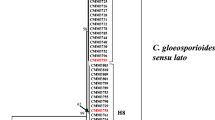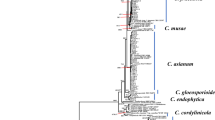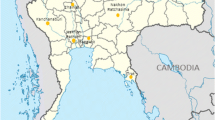Abstract
Research work was carried out to identify and ascertain the species status of the mango biotype of Colletotrichum gloeosporioides infecting mangoes in Ghana. Forty five isolates of Colletotrichum species were collected from 12 districts in Ghana while five each were obtained from mango fruits from Florida, Mexico and Puerto Rico. The entire internal transcribed spacer region, partial beta-tubulin gene and partial glyceraldehyde-3-phosphate dehydrogenase gene of isolates were sequenced and used in phylogenetic studies. The results of the sequence analysis of the first ribosomal transcribed spacer (ITS 1) region showed that 35 % of the isolates from Ghana and all the five isolates from Mexico were the mango biotype of C. gloeosporioides, while the others were not. Phylogenetic studies showed that the mango biotype of the pathogen was Colletotrichum asianum but not C. gloeosporioides as previously thought. However, the other isolates that were not the mango biotype were identified as Colletotrichum siamense and Colletotrichum species which had probably cross-infected mango from other fruit crops in the field.


Similar content being viewed by others
References
Abang, M. M (2003). Genetic diversity of Colletotrichum gloeosporioides Penz causing anthracnose disease of yam (Discorea spp) in Nigeria. Bibliotheca Mycologia. 139 pp
Alahakoon, W. P., Brown, A. E., & Sreenivasaprad, S. (1994). Genetic characterization of Colletotrichum gloeosporioides isolates obtained from mango. International Journal of Pest Management, 40(2), 225–229.
Ane, C., Larget, B., Baum, D. A., Smith, S. D., & Rokas, A. (2007). Bayesian estimation of concordance among gene trees. Molecular Biology and Evolution, 24, 412–426.
Cannon, P.F., Bridge, P.D. and Monte, E. (2000). Linking the past, present and future of Colletotrichum systematic. pg. 1–20 in Prusky D., Freeman, S and Dickman, M (eds) Colletotrichum: Host specificity, Pathology and Host-pathogen interaction. American Phytopathology Society. St. Paul.
Crane, J. H., & Campbell, C. W. (1991). The Mango. Florida Cooperation Extension Service. University of Florida: Institute of Food and Agricultural Science.
Damm, U., Baroncelli, R., Cai, L., Kubo, Y., O’Donnell, R., Weir, B., Yoshino, K., & Cannon, P. F. (2010). Colletotrichum: Species ecology and Interactions. International Mycological Association, 1(2), 161–165.
Davis, M.J. (1999). Genetic and pathological diversity of the Mango anthracnose pathogen in Florida. Proceedings. Florida State Horticultural Society
Dodd, J. C., Jeffries, P., & Jeger, M. J. (1989). Management strategies to control latent infection in tropical crops. Aspects of Applied Biology, 20, 49–56.
Dodd, J. C., Estrada, A. B., Matchmen, J., Jefries, P., & Jeger, M. J. (1991). The effect of climatic factors on Colletotrichum gloeosporioides, the causal agent of Mango anthracnose in the Philippines. Plant Pathology, 40, 568–575.
Estrada, A. B., Dodd, J. C., & Jeffries, P. (2000). Effect of humidity and temperature on conidial germination and appressorium development of two Philippine isolates of the mango anthracnose pathogen Colletotrichum gloeosporioides. Plant Pathology, 49, 608–618.
Felsenstein, J. (1985). Confidence limits on phylogenies: An approach using the bootstrap. Evolution, 39, 783–791.
Fitzell, R. D. (1979). Colletotrichum acutatum as a cause of anthracnose of mango in New South Wales. Plant Disease Reporter, 63, 1067–1070.
Fitzell, R. D. (1981). Regular application of Benomyl on the population of Colletotrichum on mango leaves. Transaction of the British Mycological Society, 98, 65–77.
Fitzell, R. D., & Peak, C. M. (1984). The Epidemiology of anthracnose disease of Mango: inoculums sources, spore production and dispersal. Annual Applied Biology, 104, 451–458.
Freeman, S., Katan, T., & Shabi, E. (1998). Characterization of Colletotrichum species responsible for anthracnose disease of various fruits. Plant Diseases, 82, 596–605.
Geiser, D. M., Pitt, J.I and Taylor, J.W. (1998).Cryptic speciation and recombination in the aflatoxin producing fungus Aspergillus flavus. Proceedings, National Academy of Sciences, U.S.A. 95: 388–393
Glass, N. L., & Donaldson, G. (1995). Development of primer sets designed for use with PCR to amplify conserved genes from filamentous ascomycetes. Applied and Environmental Microbiology 61, 1323–1330.
Govender, V., Korsten, L., & Sivakumar, D. (2005). Semi-commercial evaluation of Bacillus licheniformis to control mango postharvest diseases in South Africa. Postharvest Biology and Technology, 38, 57–65.
Hayden, H. L., Pegg, K. G., Aitken, E. A. B., & Irwin, J. A. G. (1994). Genetic relationships as assessed by molecular markers and cross infections among strains of Colletotrichum gloeosporioides. Australian Journal of Botany, 42, 9–18.
Hodson, A., Mills, P. R., & Brown, A. E. (1993). Ribosomal and mitochondrial DNA polymorphism in Colletotrichum gloeosporioides isolated from tropical fruits. Mycological Research, 97, 329–335.
Ilag, L.I (1992). Diseases of mango and their control. Paper presented during the first national symposium workshop on Mango diseases in The Philippines. Bureau of Plant Industry, March 19–20.
Jeffries, A., Dodd, J. C., Jeger, M. J., & Plumbley, R. A. (1990). The Biology and Control of Colletotrichum species on Tropical Fruit Crops. Plant Pathology, 39, 343–366.
Johnson, G. I. (1992). Biology and control of stem end rot pathogens of mango. PhD. Thesis. The University of Queensland.
Koufopanou, V., Burt, A. and Taylor, J.W. (1997). Concordance of gene genealogies reveals reproductive isolation in the pathogenic fungus Coccidiodes immitis. Proceedings, National Academy of Sciences, U.S.A. 94: 5478–5482.
Liu, B., Wasilwa, L. A., Correl, J. C., O’Neill, N., & Morelock, T. E. (2007). Comparison of Colletotrichum orbiculare and several allied Colletotrichum species for mtDNA RFLP, intron RFLP and sequence variation, vegetative compatibility and host specificity. Phytopathology, 97, 1305–1314.
Mills, P.R., Hodson, A. and Brown, A.E. (1992). Molecular differentiation of Colletotrichum gloeosporioides isolates infecting tropical fruits. p 326–336 in J.A. Bailey and M.J. Jeger (eds). Colletotrichum-Biology, Pathology and Control.Wallingford, UK; CAB International.
Muirhead, I.F. and Grattidge, R. (1986). Mango disease. p 248–252 in proceedings of the CSIRO first Australia mango research Workshop
Nei, M., & Kumar, S. (2000). Molecular Evolution and Phylogenetics. New York: Oxford University Press.
Nelson, S. C. (2008) Mango anthracnose (Colletotrichum gloeosporioides).College of Tropical Agriculture and Human Resource. Publication PD-48
O’Donnell, K., Cigelnik, E., & Nirenberd, H. J. (1998). Molecular systematics and phylogeography of the Gibberella fujikori species complex. Mycologia, 90, 465–493.
Oduro, K.A. (2000). Checklist of plant pests in Ghana.Volume 1. Diseases. Plant Protection and Regulatory Service Directorate, Ministry of Agriculture. Accra, Ghana. 105 pp.
Offei, S.K., Cornelius, E. W. and Sakyi-Dawson, O. (2008). Crop Diseases in Ghana and their Management. Smartline Publishing Limited. 104 pp
Peres, N. A. R., Kuramae, E. E., Dias, M. S. C., & De Souzza, N. L. (2002). Identification and Characterisation of Colletotrichum species affecting fruit after harvest in Brazil. Journal of Phytopathology, 150, 128–134.
Peres, N. A., Mackenzie, S. J., Peever, T. L., & Timmer, L. W. (2008). Postbloom fruit drop of citrus and Key lime anthracnose are caused by distinct phylogenetic lineages of Colletotrichum acutatum. Phytopathology, 98, 345–352.
Phoulivong, S., Cai, L., Chen, H., Mckenzie, E. H. C., Abdulsalam, K., & Chukeatirute, E. K. D. (2010). Colletotrichum gloeosporioides is not a common pathogen on tropical fruits. Fungal Diversity, 44, 33–43.
Ploetz, R. C. (1998). Anthracnose (p 35–36 in R.C Ploetz, G.A Zetmeyer, W.T Nishijima, K.G., Rohrbach and H.D). Minnesota: Ohr. Compendium of tropical fruit diseases. The American Phytopathological Society.
Ploetz, R. E. and Prakash, O. (1997) Foliar, Floral, and Soil Borne Diseases, p 281–225 in R. E. Litz (ed) The Mango: Botany, Production and Uses. Cab International Oxon. U.K.
Prihastuti, H., Cai, L., Chen, H., & Hyde, K. D. (2009). Characterisation of Colletotrichum species associated with coffee berries in Chiang Mai, Thailand. Fungal Diversity, 39, 89–109.
Prior, C., & Ryder, K. (1987). Effect of low volume copper sprays with polyisobutene sticker on mango blossom blight (Glomerella cingulata) in Dominica. Tropical Pest Management, 33, 350–352.
Sanders, G. M., & Korsten, L. (2003). Comparison of cross inoculation potential of South African avocado and mango isolates of Colletotrichum gloeosporioides. Microbiology Research, 158, 143–150.
Simmonds, J. H. (1941). Latent infection in tropical fruits discussed in part played in species of Gloeosporium and Colletotrichum. Proceedings of the Royal Society of Queensland, 53, 92–120.
Small, W. (1926). On the occurrences of a species of Colletotrichum. Transactions of the British Mycological Society, 11, 112–137.
Sudhindra, G. R., Rosenberg, M. S., & Sudhir, K. (2005). Inferring species phylogenies from multiple genes: concantenated sequence trees versus consensus gene trees. Journal Experimentalis Zool B Molecular Development Evolution, 304B, 64–74.
Talhinas, P., Sreenivasaprad, S., Neves-Martin, J., & Oliviera, A. (2005). Molecular and phenotypic analyses reveal association of diverse Colletotrichum acutatum groups and a low level of Colletotrichum gloeosporioides with olive anthracnose. Applied and Environmental Microbiology, 71, 2987–2989.
Tamura, K., Peterson, D., Peterson, N., Steicher, G., Nei, M., & Kumar, S. (2011). Molecular Evolutionary Genetics Analysis using maximum likelihood, Evolutionary Distance and Maximum Parsimony methods. Molecular Biology and Evolution, 24, 1596–1599.
Taylor, J. W., Jacobson, D., Kroken, S., Kasuga, T., David, M., Geiser, M., David, S., Hibbett, S., & Fissher, M. (2000). Ohylogenetic Species Recognition and Species Concepts in Fungi. Fungal Genetics and Biology, 31, 21–32.
von Arx, J. A. (1957). Die Arten der Gattung Colletotrichum Cda. Phytopathologische Zeitschrift, 29, 413–468.
von Arx, J. A. (1970). A revision of the fungi classified as Gloeosporium. Bibliotheque Mycologia, 24, 1–203.
von Arx, J. A., & Muller, E. (1954). Die Gattung der amerosporen Pyrenomyceten. Beitrage zur kryptogamenflora der Scheiz, 11(1), 1–434.
Weir, B. S., Johnston, P. R., & Damm, U. (2012). The Colletotrichum gloeosporioides species complex. Studies in Mycology, 73, 115–180.
White, T. J., Bruns, T., Lee, S., & Taylor, J. W. (1990). Amplification and direct sequencing of fungal ribosomal RNA genes for phylogenetics. In M. A. Innins, D. H. Gelfand, J. J. Snisky, & Y. J. White (Eds.), PCR Protocols: A guide to Methods and Application (pp. 312–322). California: Academic Press San Diego.
Acknowledgment
The authors wish to extend their gratitude to Dr. Frank Louws of The Plant Pathology Department of North Carolina State University, The office of International Programmes (University of Ghana and North Carolina State University), Students Study Abroad Office (both Ghana and U.S.A.) and The Office of Research and Innovation Development of the University of Ghana for their diverse supports to the study.
Author information
Authors and Affiliations
Corresponding author
Rights and permissions
About this article
Cite this article
Honger, J.O., Offei, S.K., Oduro, K.A. et al. Identification and species status of the mango biotype of Colletotrichum gloeosporioides in Ghana. Eur J Plant Pathol 140, 455–467 (2014). https://doi.org/10.1007/s10658-014-0480-z
Accepted:
Published:
Issue Date:
DOI: https://doi.org/10.1007/s10658-014-0480-z




